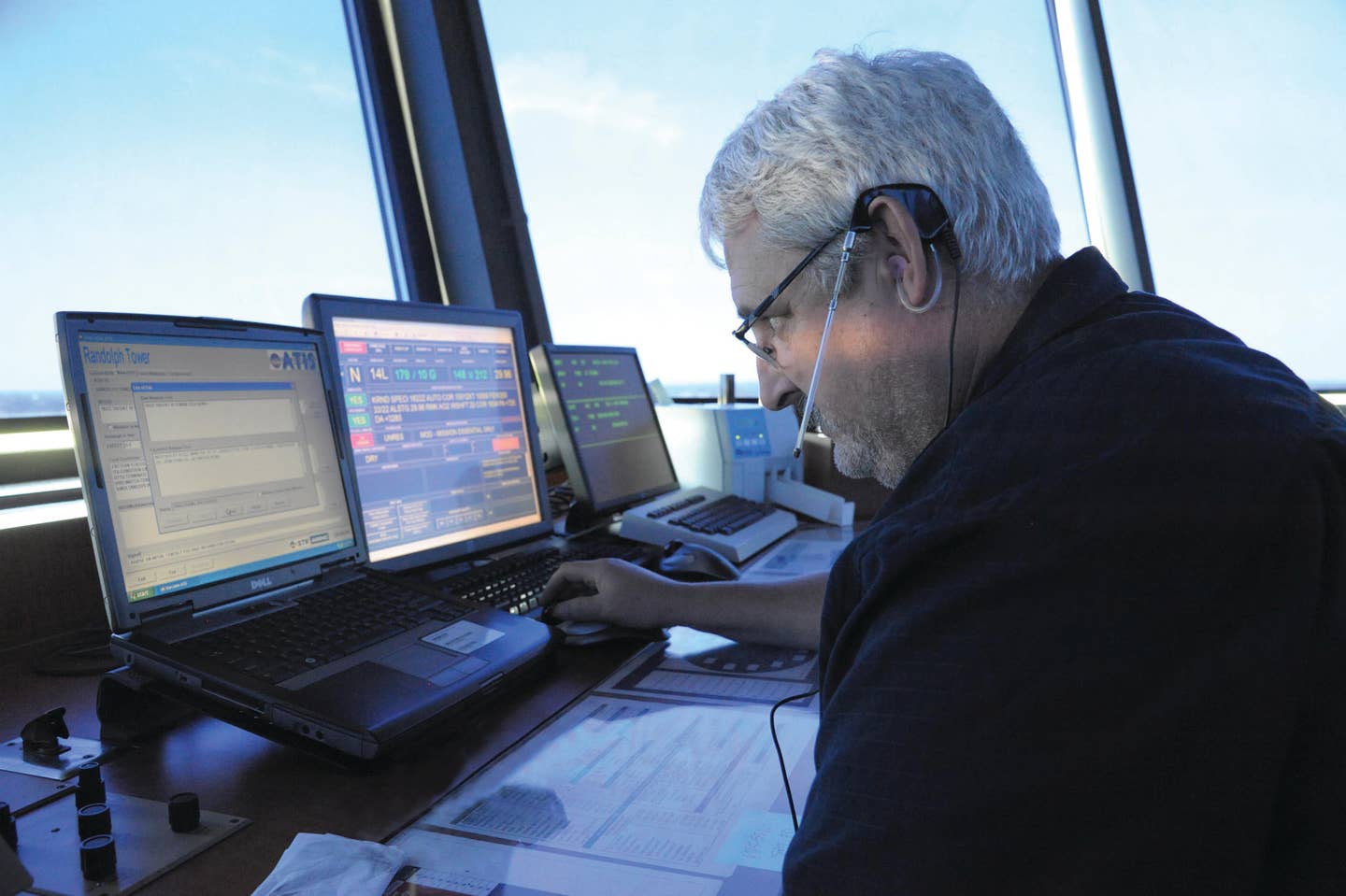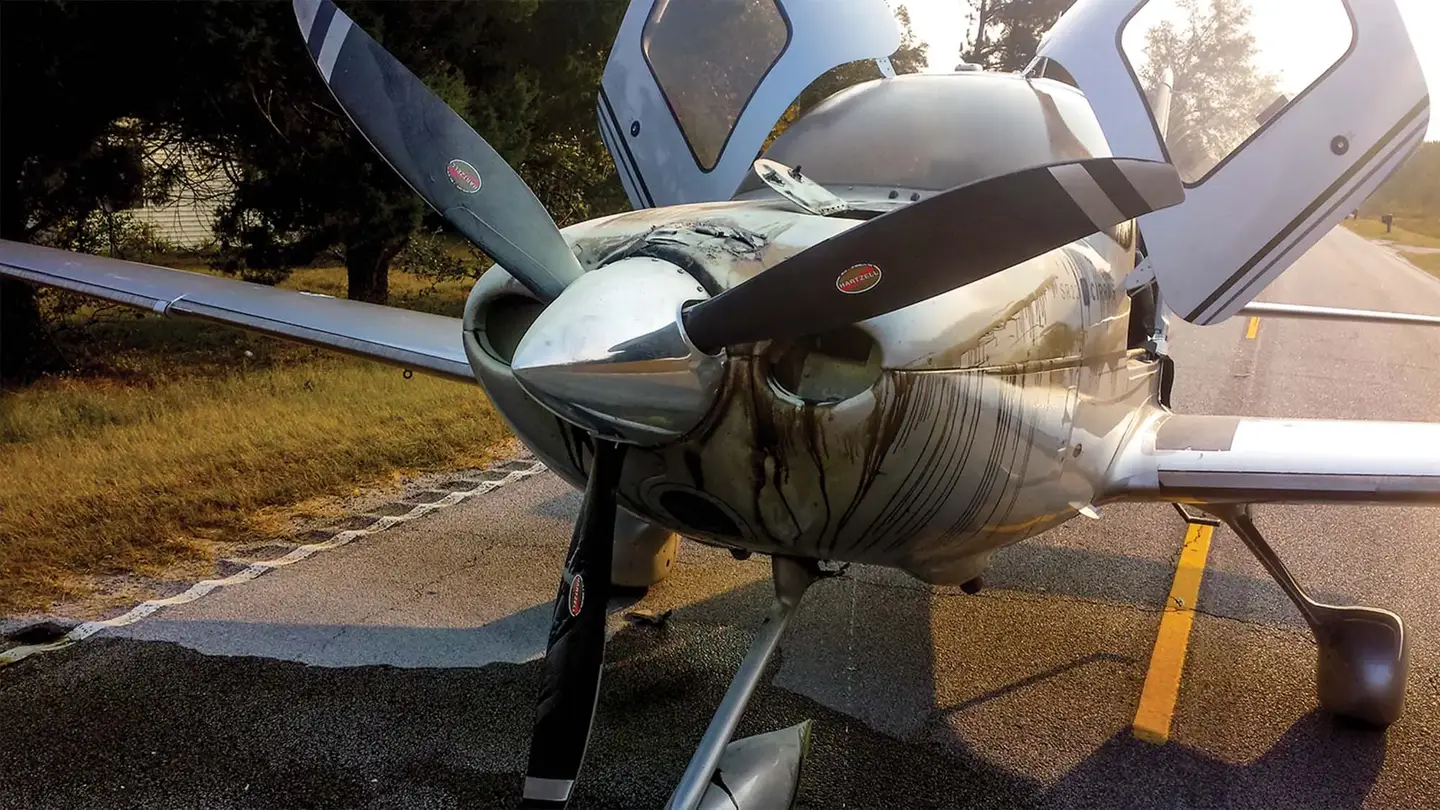The Voice In The Tower
As a working air traffic controller, I’m often introduced around the flight school as the “voice in the tower.” When conversations get around to asking about my job, it seems…

Image: Joel Martinez/DOD
As a working air traffic controller, I’m often introduced around the flight school as the “voice in the tower.” When conversations get around to asking about my job, it seems to me that new student pilots have this fear of talking on the “party-line” radio frequency. Student pilots stumble, scream, ramble, speak softly, rush through it or combine them all. Not only does everyone on the frequency hear you, but because of technologies like www.liveatc.net, the entire world can hear what you sound like. Be confident, calm and say what you need to say, then listen.
At times, it doesn’t matter what you say because the controller is busy and only listening for key words, the legal requirements. Let’s discuss the legal requirements, reading back clearances, what’s pertinent information and what goes on behind the scenes to try giving you first-hand knowledge of a controller’s point of view. The objective by the end of this article is to have a clear understanding of the responsibility between the controller and pilot. As for those who fly from non-towered airports into controlled airspace to where you must talk with someone, this will be a good refresher.
Seeing Is Believing
First things first: Pilots who use the CTAF at non-towered airports to state their intentions need to understand that towers usually have some type of radar data being fed to them, if not directly from the source. Your position reports are unnecessary unless asked to report over a specific point. As the controller, I do not need to know you are on downwind or turning your base. I can see you out the window and on the radar screen. This occupies the frequency and can prevent controllers from issuing needed traffic advisories or instructions.
We have a saying that seconds build minutes and minutes build hours, so do not waste time. Because controllers work in a constantly moving three-dimensional environment, time used on the radio adds up very quickly. If the controller is working six aircraft and they all make a five-second transmission, 30 seconds are used up. Now consider that some ATC towers are running two operations a minute, or 120 an hour, and do the math on how much time can be wasted.
Keep it short, simple and to the point. Yes; sometimes it benefits all parties to share more information, especially when it comes to non-standard airspace procedures or if an abnormal request is made that the controller must plan for. As the pilot-in-command, please use your best judgment and be courteous to others on the frequency.
Second, also be professional on the radio. Everything said on an ATC frequency is recorded and we do get audited from time to time. It is like a quality control check to see areas of improvement and to ensure that everything is being done correctly.
Lastly, when the control tower is open, controllers have full control over airport lighting. There is no need to click the mike three, five or seven times to try and turn on the lights. The lights are turned on at sunset. If the pilot needs lighting for whatever reason, please key the mic and ask the controller to turn the lights on. Just clicking the mic to turn on the lights ties up the frequency.
Phraseology, Voice
Controllers are mandated to phrase clearances or instructions in a certain order, depending on the situation. This is the bread and butter of ATC. The phraseology is continuously rehearsed and taught from day one of training and never stops.
We also are taught to sound professional on the frequency, sometimes called the “controller’s voice.” Most of us sound slightly different in person then what we do on the frequency. This is so because we must have a sense of command and trust from the pilot so they feel ensured that we will do our jobs safely, professionally and accurately.
A student pilot surprised me the other day when she asked, “Do controllers receive training on how to talk to pilots?” It was an interesting perspective. Even though we are trained to speak in a particular tone, we receive training in the field per our particular facility of how to accommodate different types of pilots. We may speak more slowly to someone who is new or may have language issues. We may be more firm in speaking to someone who is not following instructions.
Overall, we are in a “customer service” job and we are here to serve the pilots. Controllers are allowed to have training time to actually see what goes on in the cockpit, whether it being from the local flight school or an airline. Most controllers are not pilots and this training is very useful to help each profession understand their part in the system.
Is there a simple procedure to eliminate frequency congestion? Yes, and no. Controllers are required to have certain items on the tapes before they can move you. Let us start from clearance delivery.
What We Need To Hear
When relaying an IFR clearance, the controller must give it to you in a particular order: callsign, clearance limit, route, altitude, frequency and transponder code. The mnemonic for this sequence is CCRAFT. The pilot is responsible for receiving the entire clearance. If the pilot reads back everything but the altitude, the controller is not responsible if the pilot deviates from the altitude clearance. However, if the pilot reads back everything and an item is incorrect, it is the responsibility of the controller to fix the error.
Now, if the pilot reads back the fix and still busts the altitude, as an example, then the responsibility is on the pilot. Ground control works the same way. The controller will give you taxi instructions, not a clearance to the active runway. They will give you the assigned runway and assign a route. The only thing the controller needs to hear from the pilot is the runway assignment and the callsign.
In furthering this, all controllers are mandated to get a readback of runway assignments and hold-short instructions. The ATIS identifier also is a mandatory item that the controller will need to hear in order to start your taxi.
It’s always wise to write down taxi instructions and other clearances because some of these airport taxi instructions can become lengthy at large airports. Tower controllers will at bare minimum need to hear a readback of your callsign. Again, it is important from the pilot perspective to read back the clearances that are given, especially those clearances that involve takeoff/landing, crossing runway instructions, plus altitude and heading restrictions. It’s a good idea to read back everything so the controller can verify if the correct instructions were received. It also covers the pilot in eliminating the risk of a pilot deviation. As the controller, I can require you to read back any clearance or instruction that was given if I feel a simple “roger” does not satisfy mutual understanding. Remember that our job is to keep everyone safe and separated; it’s nothing personal. See the sidebar on page 9 for more details on readbacks.
Wilco All That
Being a pilot, I have been guilty of this too. I have come across controllers who speak too fast and I have actually asked them to say again or I get what they want me to do and I respond with, “Wilco all that.” It happens even to the best of us. The average adult can usually understand 260 words per minute in conversation. Thankfully, few ATC communications are so lengthy. We go from plane to plane doing this and that is why it seems fast. We just key the mic much faster than pilots because frankly, it is what we do all day long. If we’re going too fast for you, there are some methods of politely asking us to slow down.
We all know and love “say again.” This works but understand that when it gets really busy the controller may not get back to you right away. Asking the controller to speak slower is also a good way to make sure you understand their instructions. I have had controllers ask me to slow my rate of speech while flying, so I have no issue with asking them to do the same.
There is another method that you can try, but I’m not sure how well it will work: “Words twice.” The FAA’s Pilot/Controller Glossary defines this phrase as both a request and information: As a request, it means “communication is difficult; please say every phrase twice.” As information, it means, “Since communications are difficult, every phrase in this message will be spoken twice.”
I have never heard anyone use this, which would add to frequency congestion. But I have heard controllers use the callsign of the aircraft before and after the transmission to make sure that the correct aircraft “got the message” in situations involving similar-sounding callsigns. Lastly, if all else fails, use the phrase “student pilot” in your initial call. This lets us know you are a solo student and still learning.
Controllers will generally not give you any weird control instruction, nor will they speak fast to you. But don’t abuse this: Private pilots using the “student pilot” phrase is not a good look.
Now You Know
There is no need for “mic fright.” If you think you have it bad as a pilot, just remember that every controller remembers their first transmission controlling multiple aircraft. We have a job to perform and public safety is our top priority.
We all must be professional on the frequency while keeping it short and brief. Know what to say before keying the microphone; this will cut out the “uhh...ahh” moments. Affirmative means “yes” and “roger” means that you have received the transmission; letting the controller know you have traffic “in sight” rather than just saying “roger” helps ensure that we have separation.
Safe flying!
What To Read Back
Years ago, as a student pilot fumbling through the training materials trying to make sense of it all, I came across portions of the Aeronautical Information Manual (AIM) explaining ATC communications. The AIM has a lot of material in it about communications, but not that much detail regarding reading back a clearance or instruction for confirmation. The FAA order JO 7110.65Y, “Air Traffic Control,” the “bible” for controllers, has this to say at paragraph 2-4-3:
Pilot Acknowledgement/Read Back
Ensure pilots acknowledge all Air Traffic Clearances and ATC Instructions. When a pilot reads back an Air Traffic Clearance or ATC Instruction:
- Ensure that items read back are correct.
- Ensure the read back of hold short instructions, whether a part of taxi instructions or a LAHSO clearance.
- Ensure pilots use call signs and/or registration numbers in any read back acknowledging an Air Traffic Clearance or ATC Instruction.
Meanwhile, the AIM has specific, though incomplete, guidance for pilots at paragraph 4-4-7:
ATC Clearance/Instruction Readback
Pilots of airborne aircraft should read back those parts of ATC clearances and instructions containing altitude assignments, vectors, or runway assignments as a means of mutual verification.... (emphasis in original)
- Include the aircraft identification in all readbacks and acknowledgments.
- Read back altitudes, altitude restrictions, and vectors in the same sequence as they are given....
- Altitudes contained in charted procedures should not be read back unless they are specifically stated by the controller.
- Initial read back of a taxi, departure or landing clearance should include the runway assignment, including left, right, center, etc., if applicable.
- It is the responsibility of the pilot to accept or refuse the clearance issued.
Emergencies And Reporting
The pilot, ATC or a certificated carrier can declare an emergency for an aircraft in distress. For our part, at a bare minimum, ATC needs to know how many people are aboard, fuel remaining (in minutes) and the pilot’s intentions. Other information may be requested as the situation unfolds. It’s not required that you report an emergency, but we can’t help you if we don’t know you’re having a problem.
Pilots operating VFR in terminal areas may from time to time be asked to make certain reports. Examples can include a certain distance from the airport—a two-mile right base, for example—or a familiar landmark. Pilots operating on an IFR clearance have a host of required reports, including equipment failures and non-forecast weather. The fact is anything pertinent to flight safety should be reported to the ATC facility with jurisdiction for the best service and courses of action that work well for everyone.
Eric Lyn is a private pilot who works as an air traffic controller in Southern California. His views do not necessarily reflect the opinions, beliefs or specific policies of the FAA or ATC contract providers.
This article originally appeared in the February 2020 issue of Aviation Safety magazine.
For more great content like this, subscribe to Aviation Safety!






